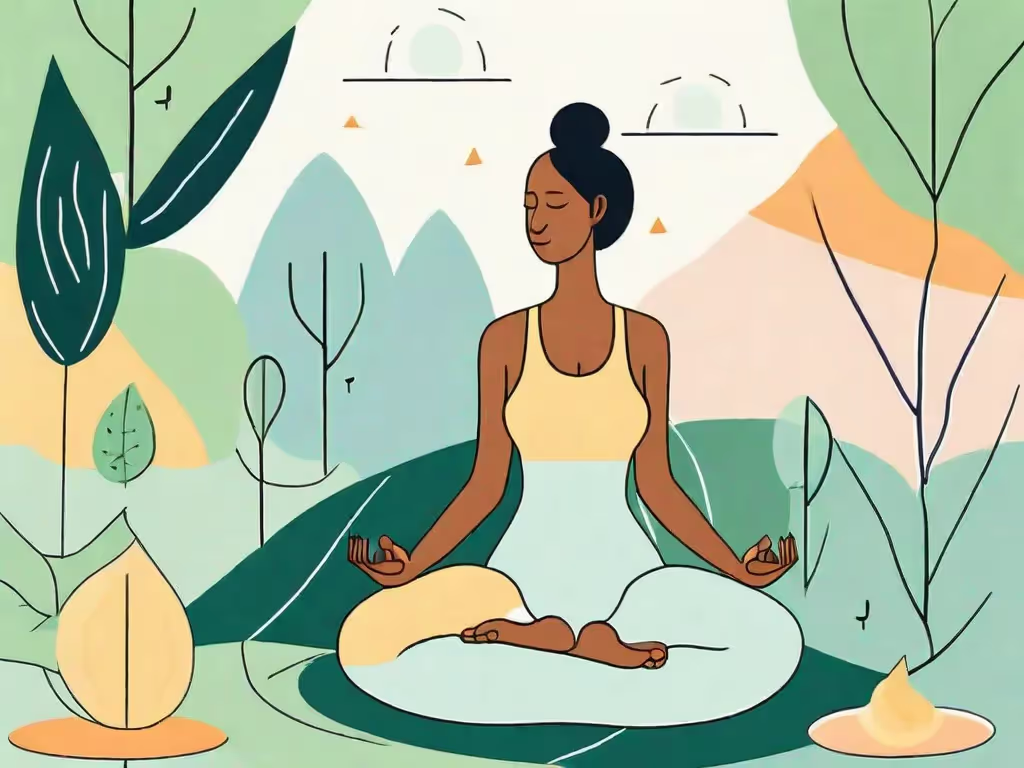Shamatha, also known as Calm Abiding, is a fundamental meditation practice in Buddhism. It is a method of training the mind to develop tranquility and focus, leading to a state of profound peace and a mind that is ready for deeper insight. The term 'Shamatha' is derived from two Sanskrit words: 'Shama' meaning 'peace' and 'Tha' meaning 'to dwell'. Therefore, Shamatha can be translated as 'dwelling in peace'.
This meditation practice is not exclusive to Buddhism, but is also found in other spiritual traditions, including Hinduism and Taoism. It is a universal technique that can be practiced by anyone, regardless of religious or philosophical beliefs. The goal of Shamatha meditation is to cultivate a calm, clear, and non-conceptual state of mind.
Origins and Historical Context of Shamatha
Shamatha meditation has its roots in ancient Indian spiritual practices. It is believed to have been practiced by the Buddha himself, and is mentioned in many Buddhist scriptures, including the Pali Canon and the Mahayana sutras. The practice of Shamatha was integral to the Buddha's path to enlightenment, and it continues to be a fundamental part of Buddhist meditation practice today.
In the centuries following the Buddha's death, the practice of Shamatha spread with Buddhism throughout Asia. It was incorporated into the meditation practices of various Buddhist schools, including Theravada, Mahayana, and Vajrayana. Today, Shamatha is practiced by Buddhists and non-Buddhists alike around the world.
Shamatha in Theravada Buddhism
In Theravada Buddhism, Shamatha is often practiced in conjunction with Vipassana, or insight meditation. The tranquility developed through Shamatha meditation is seen as a necessary foundation for the cultivation of insight. The Theravada tradition places a strong emphasis on mindfulness of breathing (Anapanasati) as a method of developing Shamatha.
Theravada texts, such as the Visuddhimagga, provide detailed instructions for practicing Shamatha. These instructions include a variety of meditation objects, such as the breath, colored disks (kasinas), and recollections of the Buddha, among others.
Shamatha in Mahayana Buddhism
In Mahayana Buddhism, Shamatha is also considered a crucial foundation for the development of insight. The Mahayana tradition, however, places a greater emphasis on the cultivation of bodhicitta, or the mind of enlightenment, which is a mind motivated by great compassion for all sentient beings.
One of the unique features of Mahayana Shamatha practice is the use of visualizations. Practitioners may visualize a Buddha or bodhisattva, or they may visualize themselves as a Buddha or bodhisattva. This practice is believed to help cultivate both concentration and compassion.
Principles and Techniques of Shamatha Meditation
Regardless of the specific tradition, the basic principles and techniques of Shamatha meditation remain the same. The practice involves choosing a meditation object and focusing the mind on that object. When the mind wanders, the practitioner gently brings it back to the object of meditation.
The meditation object can be anything that the practitioner finds helpful for developing concentration. Commonly used objects include the breath, a visual object, a sound, or a mantra. The important thing is to choose an object that the practitioner can focus on without strain or discomfort.
Posture in Shamatha Meditation
The physical posture in Shamatha meditation is important. The traditional posture is the seven-point posture of Vairochana, which includes sitting with a straight back, legs in the lotus or half-lotus position, hands resting in the lap, eyes slightly open and looking down, tongue touching the roof of the mouth, and shoulders relaxed.
However, it is not necessary to sit in this traditional posture. The most important thing is to find a posture that is comfortable and allows the practitioner to remain alert and relaxed. This could be sitting in a chair, lying down, or even walking.
Focus and Attention in Shamatha Meditation
The key to Shamatha meditation is maintaining a steady focus on the chosen meditation object. This requires a balance of attention and relaxation. If the mind is too tense, it can lead to restlessness and agitation. If the mind is too relaxed, it can lead to drowsiness and dullness.
When the mind wanders, the practitioner should gently bring it back to the meditation object without judgment or frustration. This process of noticing the wandering mind and bringing it back to the object is a crucial part of the practice. It helps to strengthen the mind's ability to remain focused and undistracted.
Benefits of Shamatha Meditation
The practice of Shamatha meditation has many benefits. It helps to calm the mind, reduce stress and anxiety, improve concentration, and promote a sense of well-being. It can also serve as a foundation for deeper meditation practices, such as Vipassana or insight meditation.
Scientific research has also shown that regular meditation can have positive effects on physical health. It can lower blood pressure, improve sleep, boost the immune system, and even slow the aging process. Furthermore, meditation can lead to structural changes in the brain, increasing gray matter density in areas associated with memory, sense of self, empathy, and stress.
Psychological Benefits of Shamatha Meditation
One of the main psychological benefits of Shamatha meditation is its ability to reduce stress and anxiety. By focusing the mind on a single object, the practitioner can let go of worry and rumination. This can lead to a state of deep relaxation and peace.
Shamatha meditation can also improve concentration and mental clarity. Through the practice of continually bringing the mind back to the meditation object, the practitioner can develop a sharper, more focused mind. This can be beneficial in many areas of life, including work, study, and creative pursuits.
Physical Benefits of Shamatha Meditation
Shamatha meditation can also have physical benefits. Research has shown that regular meditation can lower blood pressure, improve heart health, and boost the immune system. It can also improve sleep quality and increase energy levels.
Furthermore, meditation can lead to changes in the brain. Studies have shown that regular meditation can increase gray matter density in areas of the brain associated with memory, sense of self, empathy, and stress. This suggests that meditation can not only improve mental health, but also lead to structural changes in the brain.
Challenges and Obstacles in Shamatha Meditation
While the practice of Shamatha meditation is simple in theory, it can be challenging in practice. One of the main challenges is dealing with a wandering mind. It is natural for the mind to wander, and it can be frustrating when it continually drifts away from the meditation object.

Another challenge is dealing with physical discomfort. Sitting still for extended periods can lead to physical discomfort, such as pain in the knees, back, or neck. It is important to find a comfortable posture and to take breaks when needed.
Dealing with a Wandering Mind
The wandering mind is a common challenge in Shamatha meditation. It is natural for the mind to wander, and it can be frustrating when it continually drifts away from the meditation object. However, it is important to remember that noticing the wandering mind and bringing it back to the object is a crucial part of the practice.
When the mind wanders, the practitioner should gently bring it back to the meditation object without judgment or frustration. This process of noticing the wandering mind and bringing it back to the object helps to strengthen the mind's ability to remain focused and undistracted.
Dealing with Physical Discomfort
Physical discomfort is another common challenge in Shamatha meditation. Sitting still for extended periods can lead to discomfort, such as pain in the knees, back, or neck. It is important to find a comfortable posture and to take breaks when needed.
The traditional seven-point posture of Vairochana is often recommended for Shamatha meditation. However, it is not necessary to sit in this posture. The most important thing is to find a posture that is comfortable and allows the practitioner to remain alert and relaxed. This could be sitting in a chair, lying down, or even walking.
Conclusion: The Power of Shamatha Meditation
In conclusion, Shamatha meditation is a powerful practice for cultivating a calm, clear, and focused mind. It is a foundational practice in Buddhism, but can be practiced by anyone, regardless of religious or philosophical beliefs. The practice involves focusing the mind on a chosen object and continually bringing it back when it wanders.

The benefits of Shamatha meditation are numerous. It can reduce stress and anxiety, improve concentration and mental clarity, and promote a sense of well-being. It can also serve as a foundation for deeper meditation practices, such as insight meditation. Despite the challenges, with patience and perseverance, anyone can experience the profound peace and clarity that come from dwelling in Shamatha, or calm abiding.



.webp)






.avif)

%20(1).avif)


.avif)
.avif)
.webp)


.avif)


















































































































.avif)

















.svg)









